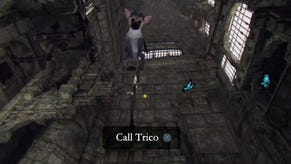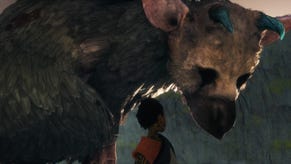The Last Guardian
Fumito's secret.
The difference, of course, is that his companion is a 30-foot mythical beast – Ueda's calling it Trico, which was the game's codename – that looks like a sort of cub chimaera. You'll need to use Trico's power and size to help you progress, employing it as a kind of sentient platform, clambering up its feathered hide to reach higher areas, just as you did with the vast granite golems of Shadow of the Colossus.
The demo starts with a deep-voiced, elderly narrator setting the scene in Japanese, and the boy standing next to the sleeping creature. The soundscape is familiar – the hollow drone of wind through man-made stone canyons – as is the artwork's combination of moody, monolithic ruin with fine, feathery detail.
But The Last Guardian doesn't have the opaque, almost monochrome visuals of its predecessors. It's given a much more vivid look by a scattering of brightly coloured butterflies amid swirling particle effects, and the extremely bright, high-contrast splashes of sunlight that streak across the creature's back in the gloom. The PS3's high resolution and ability to draw environments far into the distance sharpen things up, too.
The boy tugs on Trico's ear to wake it up (Ueda is careful not to give the creature a gender) and their mini-adventure begins. Trico stretches, yawning and shaking off its slumber, clumsy and kitten-like, but with every movement accompanied by deafening thuds to bring home its tremendous weight and size.
Its animation is astonishingly lifelike. So is the flappy-limbed, unselfconscious energy of the boy, Ueda's youngest and most human protagonist to date. Sailing against the wind, Team Ico refuses to use any form of motion-capture, using hand-crafted step-by-step keyframe animation instead. The studio's gifted animators marry the tiny, exquisite observations you might see in a hand-drawn Miyazaki film to complex 3D models and sophisticated AI. It's a mind-blowing achievement.
"Recently, mocap's becoming more and more popular, but the benefit of keyframe is that you can really control the movements you are displaying," says Ueda. "That's what I feel is the benefit. And especially in the case of this game, because we've got Trico which is a combination of various different animals, and it has the traits of a cat in some instances, and some traits of a dog – there's no animal that you could motion capture in this case!"
Ueda explains that, unlike the obedient Yorda in Ico and Agro (the horse) in Shadow of the Colossus, Trico very much has a mind of its own. To begin with, the boy will have to find ways to cajole the beast into following; later, their relationship will develop so Trico will listen to him more readily, and he may even develop some tools for commanding it. "This is very early in the game... the relationship between the boy and Trico is very shallow. So Trico will have a tendency to not interact with you," he says.
Watching the huge creature twist and snuffle and root around in a large room as if trapped in a cage, I begin to understand why this game is taking so very long to make. Selling this being to the player as a living creature, giving its behaviour enough detail that you can read its moods and intentions, and programming its AI path-finding with a minimal reliance on scripting has been a monumental challenge, Ueda admits. "The most difficult thing is to get such a large AI character moving properly in such small, confined spaces."










.png?width=291&height=164&fit=crop&quality=80&format=jpg&auto=webp)




.jpg?width=291&height=164&fit=crop&quality=80&format=jpg&auto=webp)
